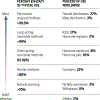A brief history and future prospects of contraception
- PMID: 37053322
- PMCID: PMC10615352
- DOI: 10.1126/science.adf9341
A brief history and future prospects of contraception
Abstract
Modern contraception ushered in an era of improved family planning, but more than 60 years after approval of "the pill," product gaps and unmet needs still exist. Nearly 250 million women worldwide who want to delay or avoid pregnancy do so ineffectively or not at all, and the principal mechanism of male contraception, condoms, has not changed in 100 years. As a result, about half of the pregnancies that occur globally each year are unintended. Increasing contraceptive options and uptake will curtail abortions, empower women and men, promote healthy families, and moderate population growth that overtaxes the environment. This Review addresses the history of contraception, shortcomings in contraceptive methods, promising approaches for male and female contraception, and simultaneous protection against unintended pregnancy and sexually transmitted infections.
Figures
References
-
- McFarlane I, Ed., State of the World Population 2022 (United Nations Population Fund, 2022).
-
- WHO, “The Global Health Observatory (Life expectancy at birth)” (WHO, 2023).
Publication types
MeSH terms
Grants and funding
LinkOut - more resources
Full Text Sources
Medical
Research Materials




